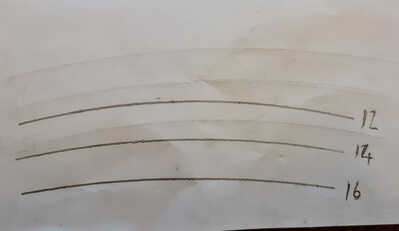My curiosity got the better of me so I rigged up a crude jig and drew a 12, 14 and 16 inch radius to see the difference, needless to say it's not a lot!
Looks like you could use a 12 ich bridge with a 16 radius board without any major issues. I always had it in my head there'd be a bigger difference.
My curiosity got the better of me so I rigged up a crude jig and drew a 12, 14 and 16 inch radius to see the difference, needless to say it's not a lot!
I've never really understood why some guitarists are so insistent that they can "only" play a guitar with X, Y, or Z radius, or a scale length of this, that or the other, or only 21, 22 or 27.5 frets (etc).
I have no idea about those specs on most of my guitars. Sure, some feel different when I play them, but that's what I want from having different guitars - a different feel and sound from them.
I can play them all equally badly.
Online guitar making courses – guitarmaking.co.uk
What's the an advantage to having a flatter fretboard, I'm not a player, still learning?
(Allegedly), it's easier to play and bend single notes vs easier to play chords. But I can never remember which is supposedly easier to do on which sort of radius!
Acoustics tend to be flatter, so I guess that implies that single notes are easier on flatter radiused boards, and chords on more radiused boards, but that's pure guess ...
Online guitar making courses – guitarmaking.co.uk
@robin a tighter radius is meant to be more comfortable for chords but if bending a string doing solos the string can choke out because you're pushing up hill so to speak. With a flatter radius you can have the strings low and do big bends without them choking out.
@tv101 the thing that gets me is a compound radius, they're often 12 to 16 but there's so little in it it seems a bit pointless. I think between a 7.5 or 9 and a 16 you'd notice it more but those three seem way to similar to be very noticeable at all.



